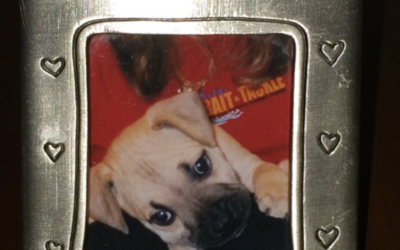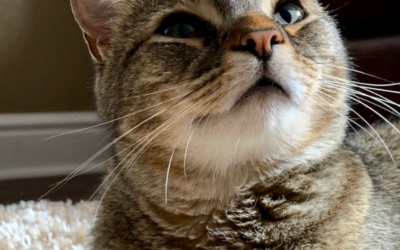Vestibular Syndrome In Dogs And Cats
Jake And Maggie enjoying a nap on the couch in clean, warm blankets out of the dryer 🙂
I have been using Tide Free and Gentle for years now with no dyes or perfumes. A vet recommended it to me when my first dog, Bear, was suffering with allergies.
Bow ties are from Pampered Pooches! Use code “twolabs” for 10% off your order.

Vestibular disease refers to a sudden, non-progressive disturbance of balance. It is more common in older dogs. It is also referred to as old dog vestibular syndrome and canine idiopathic vestibular syndrome.
Most dogs present with the sudden onset of loss of balance, disorientation, head tilt, and irregular jerking eye movements called nystagmus. Many dogs will become reluctant to stand or walk. Most dogs will lean or fall in the direction of their head tilt.
What causes vestibular disease?
Causes of vestibular disease include middle or inner ear infections, drugs that are toxic to the ear, trauma or injury, tumors, and hypothyroidism. When no specific cause is found, the condition is called idiopathic vestibular syndrome. These cases are distinguished by the sudden onset of clinical signs and the subsequent rapid improvement with little, if any, medical intervention.

Causes of Vestibular Disease in Dogs
Various causes of vestibular disease in dogs include:

Diagnosis is based on medical history, clinical signs, and the results of blood and urine tests. In some cases, diagnostic testing might include blood pressure measurement, or radiographs (X-rays) of the head to assess the appearance of the middle and inner ears and the tympanic bullae. Occasionally, magnetic resonance imaging (MRI) or computed tomography (CT) scans will be performed to look for tumors or other abnormalities. Brainstem auditory evoked response (BAER) testing may also be performed in some patients.


Treatment is directed at the underlying cause, if one can be identified. In severe cases, supportive therapy such as intravenous fluids and hospitalization may be required until the dog can eat and walk on its own. If the dog is seriously disoriented or ataxic (stumbling, unable to stand or walk), it may be given sedatives to help it relax. Drugs that help combat nausea or motion sickness may be beneficial. Antibiotics may be used in cases suspected of having middle or inner ear infections. Although corticosteroids have been used in the past, there is little scientific evidence to support their use in this condition and are generally not recommended.
What is the prognosis for a dog diagnosed with vestibular disease?
The clinical signs associated with vestibular disease are often most severe during the first twenty-four to forty-eight hours. Many pets begin to improve within seventy-two hours. The head tilt and stumbling often improve over a seven to ten-day period. Most patients are completely recovered within two to three weeks, although some will have residual symptoms such as a head tilt or mild “wobbling” for life.
If the patient fails to improve or worsens, then a more severe underlying disorder should be suspected, and advanced diagnostic testing should be pursued. A referral to a veterinary neurologist may be advised. You should see a vet immediately if your dog or cat shows any of these signs mentioned above.


I’m Bobbi Jo, a lab-lover who took my passion for animals and dogs and turned it into something bigger. When I adopted Jake and Maggie, my love for them became the driving force behind Two Adorable Labs, and my blog was born. My hope is to not only share them with the world, but to help educate others on the importance of animal health and well-being.
I love hearing from all of you and do my best to respond to each and every one of you. I always enjoy your comments, feedback, and suggestions so keep them coming! If I’ve posted a recipe (for our human and our furry friends) and you try it, don’t forget to tag me on Instagram @twoadorablelabs and use #twoadorablelabs.
If you do try and love my recipes, I would greatly appreciate a comment and rating. I read every single one and respond to them. It also lets Google know that the website contains quality content. The more comments and 5-star ratings, the more Google will show my blog in search results! Thank you so much!
As an Amazon Associate, I earn from qualifying purchases.

You Might Also Like
What Are The Nutritional Stages Over A Dog’s Lifespan?
Happy Wednesday everyone! It’s been a minute since I last posted. It’s been a crazy busy time for us and it doesn’t look like it’s going to stop any time soon but I didn’t forget about you. I’m back and ready to blog! One of my loyal readers has suggested I create...
Your Dog’s Zodiac Sign
Happy Wednesday everyone! Ever wonder what your pet's reaction means to something? Your Dog's Zodiac Sign is a fun post that sheds light on their behavior based on the month they were born. Jake and Maggie are Gemini's born June 8, 2017! The horoscope (see chart)...
The Stigma Surrounding The Pitbull Breed
Happy Wednesday everyone! Today on the blog we are talking about The Stigma Surrounding The Pitbull Breed. For those of you who have never owned a Pitbull, I want to tell you that they are a wonderful breed. So when I heard about the UK banning all XL bully dog...
What Is A Cat’s Primordial Pouch?
Happy Wednesday everyone! Today on the blog we are answering What Is a Cat's Primordial Pouch? My sister adopted a kitten and as he grows, he is developing a very large stomach. I commented on how big he is getting and she said it’s a Primordial Pouch. As soon as...
History Of The Alpha Dog
Happy Wednesday everyone! Last year I posted every day in the month of December celebrating the 24 days before Christmas but I’ve decided not to bombard you with emails and chose an interesting topic on the History of Alpha Dogs. How is the “Alpha” or “Pack Leader”...
Snuffle Mat For Your Pet’s Entertainment
Happy Wednesday everyone! Looking for treats and pet enrichment toys that can entertain and keep your pet busy? This Snuffle Mat (#ad) is one of the best toys I have ever bought Jake and Maggie! They love it. Made with polar fleece material, it is soft, durable,...







0 Comments